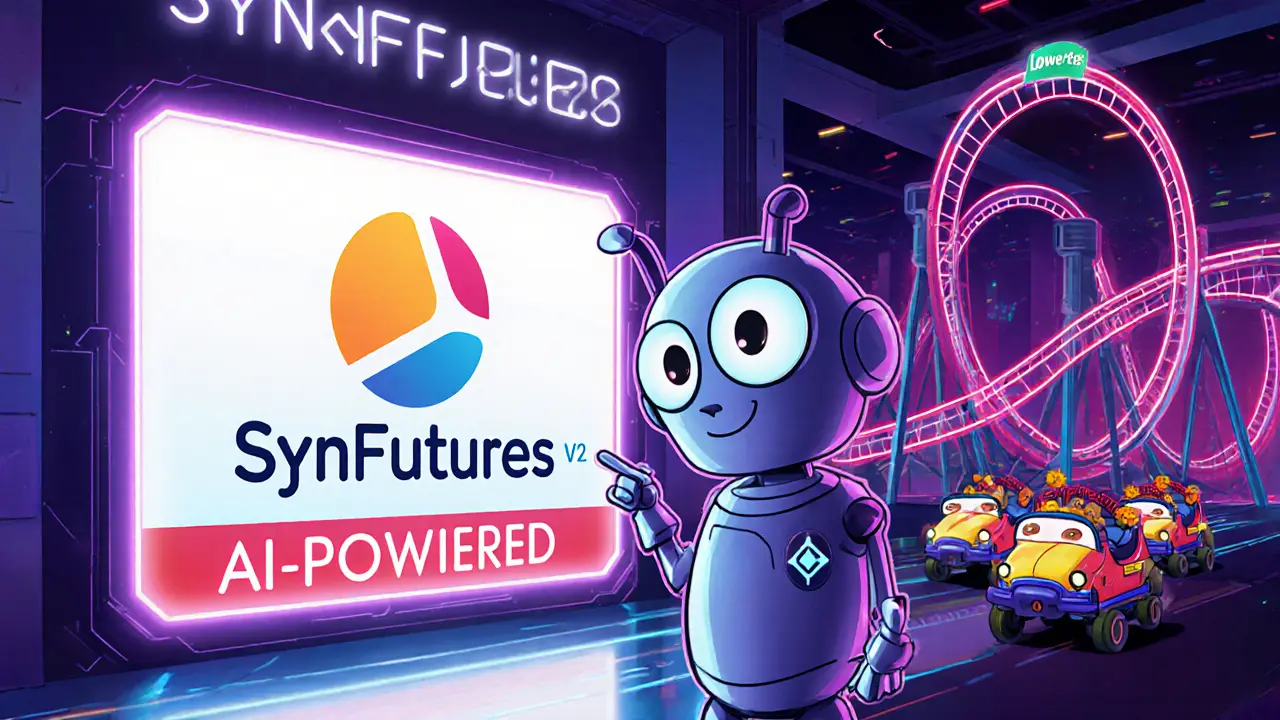SynFutures v2 Review: AI-Powered Decentralized Futures Exchange
 Oct, 19 2025
Oct, 19 2025
SynFutures Risk & Profit Calculator
Trade Inputs
AI Risk Assessment
Leverage Factor: 1x
Margin Required: $0
Liquidation Price: $0.00
Estimated Profit/Loss: $0.00
*Based on current price vs. entry price
Looking for a next‑gen platform that blends AI, low‑cost rollups and on‑chain derivatives? SynFutures review digs into the mechanics, tokenomics and user experience of SynFutures v2 so you can decide if it fits your trading style.
What is SynFutures v2?
SynFutures is a decentralized derivatives exchange built on Base Layer 2 that offers AI‑enhanced perpetual futures, synthetic assets and NFT‑linked contracts. Launched as the first DEX on the Base optimistic rollup, it promises sub‑cent gas fees, near‑instant settlement and permissionless listing of new synthetic products.
Key Technical Features
The platform’s edge comes from four intertwined components:
- AI‑driven optimization constantly refines liquidity provisioning, slippage prediction and risk assessment using machine‑learning models trained on on‑chain data.
- Automated Market Maker (AMM) tailored for derivatives, allowing traders to open leveraged positions without a traditional order book.
- Perpetual Futures that are fully collateralized - you must lock crypto as margin, and funding rates keep contract prices aligned with spot markets.
- Synthetic Assets covering everything from blue‑chip coins to Bitcoin hash‑rate tokens and NFT price exposure.
Because it lives on Base, transaction costs are typically 5‑10× cheaper than Ethereum mainnet, while the underlying smart contracts stay fully compatible with the broader Ethereum ecosystem. Users can connect any wallet that supports ERC‑20 tokens (MetaMask, Coinbase Wallet, etc.) and instantly tap into existing DeFi liquidity pools.
Tokenomics and Price Outlook
The native governance token, F, serves three core purposes: staking for fee rebates, voting on new synthetic listings, and providing collateral for certain high‑risk contracts. As of October 2025, F trades around $0.014, but forecasts vary widely:
- CoinLore predicts a 492 % rise to $0.0862 by year‑end 2025.
- TradingBeast sees a range of $0.0178-$0.032 for 2025.
- 3commas projects a low of $0.0132 and a high near $0.0164 throughout 2025‑2028.
Volatility remains high - September 2025 recorded a 95 % monthly jump, while other months suffered double‑digit drops. The consensus is that price swings will track platform adoption, AI‑feature releases and broader crypto market sentiment.

User Experience, Security and Community Sentiment
First‑time users report a straightforward onboarding flow: install a Web3 wallet, bridge assets to Base, approve the F token, and start trading. The UI highlights real‑time funding rates, liquidation thresholds and an AI‑generated risk score for each contract.
Security audits have been performed by reputable firms, focusing on smart‑contract bugs and AI model manipulation. Nonetheless, community chatter on Discord and Reddit is split - early adopters praise the low fees and innovative product range, while skeptics warn about the nascent AI layer and the inherent volatility of synthetic derivatives. The recurring advice is to “do your own research” and never allocate more than you can afford to lose.
How SynFutures Stacks Up Against Competitors
| Feature | SynFutures v2 | dYdX | Kwenta |
|---|---|---|---|
| Layer | Base (Optimistic Rollup) | StarkEx (ZK‑Rollup) | Optimism |
| AI‑enhanced AMM | Yes (ML‑driven liquidity) | No | No |
| Perpetual Futures | Fully collateralized | Margin‑based | Margin‑based |
| Synthetic Asset Variety | Crypto, NFTs, Bitcoin hash rate, custom tokens | Crypto only | Crypto only |
| Gas Fees (average) | ~$0.0005 per trade | ~$0.001 on StarkNet | ~$0.0008 on Optimism |
| Governance Token | F | DYDX | KWENTA |
In short, SynFutures offers the most diverse synthetic catalog and the only AI‑driven AMM among the three, while dYdX leads on ultra‑low fees after its upcoming gas‑free upgrade. Kwenta sits in the middle, focusing on a sleek UI but lacking AI features.

Pros & Cons Checklist
- Pros
- AI‑powered liquidity reduces slippage.
- Base Layer 2 ensures cheap, fast transactions.
- Broad synthetic asset universe (including NFTs and hash‑rate).
- Permissionless listing encourages community innovation.
- Governance token provides staking rewards.
- Cons
- AI model opacity can be a black‑box risk.
- Derivatives are inherently high‑risk; liquidation possible.
- Relatively new platform - lower liquidity than legacy DEXes.
- Price forecasts for F are highly divergent.
Step‑by‑Step: Getting Started on SynFutures
- Install a Web3 wallet (MetaMask recommended) and switch the network to Base.
- Bridge ETH or USDC from Ethereum to Base using the official Bridge UI.
- Visit the SynFutures website, click “Connect Wallet”, and approve the connection.
- Deposit collateral (e.g., USDC) into the AMM pool; the UI will display your max leverage.
- Select a contract - perpetual futures for BTC, a synthetic NFT index, or a hash‑rate token.
- Set your position size, review the AI‑generated risk score, and hit “Open Position”.
- Monitor funding rates and liquidation thresholds in real time. Use the built‑in stop‑loss feature if needed.
- When ready, close the position, withdraw collateral, and bridge any remaining funds back to Ethereum.
Remember: always start with a small position to gauge how the AI‑adjusted pricing behaves under market stress.
Final Takeaway
SynFutures v2 packs a lot of innovation into a single DEX - AI‑driven AMM, cheap L2 execution, and a truly open synthetic market. If you’re comfortable with the risk profile of perpetual contracts and want to experiment with AI‑adjusted liquidity, it’s worth a test‑drive. Traders who prioritize ultra‑deep liquidity or a proven track record may still gravitate toward older platforms like dYdX, but SynFutures is carving out a distinct niche that could pay off as DeFi derivatives mature.
What blockchain does SynFutures run on?
SynFutures is built on Base, an Optimistic Rollup of Ethereum that offers low fees and fast finality.
Do I need to hold the F token to trade?
No. You can trade with any supported collateral (USDC, ETH, etc.). Holding F gives you fee rebates and voting rights, but it’s not required to open positions.
How does the AI component improve trading?
The AI model constantly analyzes on‑chain order flow, price volatility and pool depth to adjust AMM curves, predict slippage and set optimal funding rates, resulting in tighter spreads for traders.
What types of synthetic assets can I trade?
SynFutures supports crypto pairs, NFT index contracts, Bitcoin hash‑rate tokens, and allows permissionless creation of new synthetic tokens after community voting.
Is my capital safe on SynFutures?
Capital is locked in smart contracts and can be liquidated if the position breaches maintenance margin. Audits have verified contract integrity, but the platform’s AI layer and market volatility add extra risk layers.
Prerna Sahrawat
October 19, 2025 AT 09:32SynFutures v2 represents a bold stride into the era where artificial intelligence intertwines with decentralized finance, and the implications ripple far beyond mere fee reductions. The platform’s AI‑driven AMM reshapes liquidity provisioning by continuously ingesting on‑chain volume data, thereby fine‑tuning the curve to mitigate slippage in ways traditional order books cannot emulate. Moreover, the decision to deploy on Base, an Optimistic Rollup, reduces transaction costs to a fraction of Ethereum mainnet, which practically democratizes access for retail traders who were previously priced out. The synthetic asset suite, extending beyond standard crypto pairs to include NFTs and Bitcoin hash‑rate tokens, introduces a diversified exposure that could attract institutional capital seeking novel hedging instruments. However, the opacity of the underlying machine‑learning models raises concerns about model drift and potential market manipulation, especially when the AI autonomously adjusts pricing parameters. Risk assessment tools embedded in the UI, such as the AI‑generated risk score, do provide a veneer of safety, yet they rely on the same algorithms they aim to regulate, presenting a classic feedback loop dilemma. From a tokenomics perspective, the governance token F offers staking incentives and voting rights, but its price volatility-evidenced by a 95 % monthly swing-suggests that speculative trading could dominate over genuine utility. Audits have reportedly cleared critical smart‑contract vulnerabilities, yet the novelty of integrating AI into the core trading engine means that new attack vectors remain largely unexplored. For traders accustomed to deep liquidity on legacy platforms like dYdX, the comparatively thinner pools on SynFutures might result in higher price impact during large orders, despite the AI’s best efforts to smooth the curve. The permissionless listing mechanism, while fostering community innovation, could also flood the market with low‑quality synthetic tokens, diluting overall user confidence. In practice, the onboarding experience is streamlined: a wallet connection, a simple bridge to Base, and a few clicks to deposit collateral; nevertheless, the learning curve associated with understanding AI‑adjusted funding rates may deter newcomers. Ultimately, the platform’s success hinges on its ability to balance cutting‑edge technology with transparency, ensuring that the AI enhancements serve as an augment rather than an opaque oracle dictating market dynamics.
Anna Kammerer
October 19, 2025 AT 12:52Nice rundown, but let’s be real: AI can’t magically fix a thin order book, so expect occasional whipsaws when the model over‑optimizes liquidity. If you’re not comfortable with a bit of algorithmic opacity, stick to the classics.
Mike GLENN
October 19, 2025 AT 16:12The integration of AI into the AMM is fascinating, yet it adds another layer of complexity that traders need to monitor. Keep an eye on the AI‑generated risk scores; they can be a good early warning system before a liquidation event.
BRIAN NDUNG'U
October 19, 2025 AT 19:32For those new to synthetic derivatives, I recommend starting with the smallest leverage possible and using the built‑in stop‑loss feature. The low‑cost environment on Base makes it a suitable playground for experimentation.
Ryan Comers
October 19, 2025 AT 22:52🚀🚀🚀
mike ballard
October 20, 2025 AT 02:12From a protocol architecture standpoint, the marriage of optimistic rollup scalability with AI‑enhanced pricing curves presents a compelling case study for frontier DeFi engineering.
Molly van der Schee
October 20, 2025 AT 05:32It’s easy to get swept up by the hype, but remember that every leveraged position carries inherent risk. Treat the AI as a helpful assistant, not a crystal ball.
Mike Cristobal
October 20, 2025 AT 08:52People should think twice before glorifying any platform that rewards reckless speculation. Ethics matter, even in code.
Johanna Hegewald
October 20, 2025 AT 12:12To trade on SynFutures you don’t need the F token; any supported collateral like USDC works fine.
Benjamin Debrick
October 20, 2025 AT 15:32Indeed; the platform’s tokenomics are, shall we say, an intricate tapestry of staking incentives, voting mechanisms, and collateral utility-each thread interwoven with the others, thereby creating a symbiotic ecosystem; however, one must not overlook the inherent volatility that can, and frequently does, destabilize the very equilibrium it seeks to sustain.
Joy Garcia
October 20, 2025 AT 18:52What they don’t tell you is how the AI could be a backdoor for market manipulation-just imagine the chaos if someone hijacks those models!
Erik Shear
October 20, 2025 AT 22:12Looks promising but stay cautious.
Tom Glynn
October 21, 2025 AT 01:32Think of the AI as a coach that nudges you toward better entry points; use it, but keep your own strategy front and centre.
Andrew Smith
October 21, 2025 AT 04:52Team effort! Let’s share our findings and help each other navigate this new frontier safely.
Tom Grimes
October 21, 2025 AT 08:12When you first open a position, the UI will show a risk score that changes in real time based on market volatility and the underlying AI predictions. If the score spikes, it’s a signal to tighten your stop‑loss or reduce leverage. The funding rates are also dynamic, meaning they can swing faster than on traditional perpetuals, so you need to monitor them closely. My experience so far is that the AI does a decent job of smoothing out slippage on midsized trades, but on very large orders the curve still bends noticeably. Also, remember that any liquidation event will automatically sell your collateral to cover the shortfall, so never allocate more than you’re willing to lose. Finally, keep an eye on the governance token’s price-its swings can affect your staking rewards dramatically.
Paul Barnes
October 21, 2025 AT 11:32AI helps, but it’s not a crystal ball.
John Lee
October 21, 2025 AT 14:52Curious about how the AI model updates its parameters-does anyone know the frequency of retraining? I’d love to see a transparent report on that.
Jessica Pence
October 21, 2025 AT 18:12Don't forget you can always bridge back to Ethereum if you need higher liquidity; the process is simple but watch out for bridge fees!
johnny garcia
October 21, 2025 AT 21:32In conclusion, while SynFutures v2 showcases innovative integration of AI within a DeFi framework, prudent risk management remains paramount; participants should balance enthusiasm with disciplined exposure.
Ty Hoffer Houston
October 22, 2025 AT 00:52Happy to see the community experimenting-let’s keep sharing tips and keep it friendly!
Elizabeth Chatwood
October 22, 2025 AT 04:12Go try it out its lit
Jireh Edemeka
October 22, 2025 AT 07:32Oh sure, because adding a few lines of AI code automatically guarantees security-sarcasm intended.
Jon Miller
October 22, 2025 AT 10:52Can't believe people are already talking about AI like it's the end of all crypto woes-dramatic much?
Rebecca Kurz
October 22, 2025 AT 14:12Be wary; the AI model could be hiding hidden biases, leading to unpredictable market behavior!!!